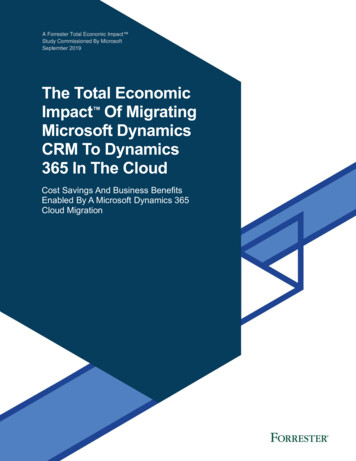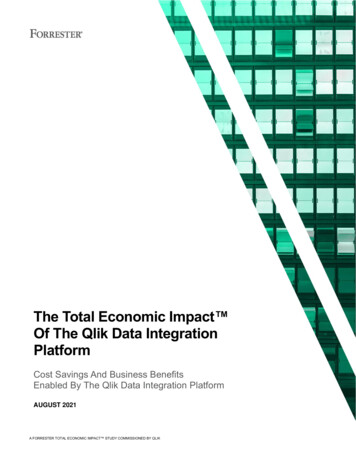
Transcription
The Total Economic Impact Of Microsoft Teams Calling SolutionsCost Savings And Improved Collaboration For EnterpriseAnd SMB OrganizationsFebruary 2021A FORRESTER TOTAL ECONOMIC IMPACT STUDY COMMISSIONED BY MICROSOFT
Table Of ContentsExecutive Summary. 1Consulting Team: Jonathan LipsitzJon EricksonThe Microsoft Teams Calling Customer Journey. 7Key Challenges . 7Composite Organizations . 8Microsoft Teams Calling For EnterpriseCustomers Financial Analysis . 9Improved Communication . 9Replaced Previous Voice Solutions . 10Replaced Telephony Support Effort . 12Unquantified Benefits . 13Flexibility. 13Internal Costs . 14External Licenses And Usage . 15Other External Costs . 16Microsoft Teams Calling For SMB CustomersFinancial Analysis . 18Improved Communication . 18Replaced Previous Voice Solutions . 19Replaced Telephony Support Effort . 21Unquantified Benefits . 22Flexibility. 22Internal Costs . 23Eternal Licenses And Usage . 24Other External Costs . 24Financial Summary – Microsoft Teams Calling ForEnterprise Customers . 26Financial Summary – Microsoft Teams Calling ForSMB Customers . 27Appendix A: Total Economic Impact . 28Appendix B: Endnotes . 29ABOUT FORRESTER CONSULTINGForrester Consulting provides independent and objective research-based consulting to help leaders succeed in theirorganizations. For more information, visit forrester.com/consulting. 2021, Forrester Research, Inc. All rights reserved. Unauthorized reproduction is strictly prohibited. Information is based onthe best available resources. Opinions reflect judgment at the time and are subject to change. Forrester , Technographics ,Forrester Wave, RoleView, TechRadar, and Total Economic Impact are trademarks of Forrester Research, Inc. All othertrademarks are the property of their respective companies.THE TOTAL ECONOMIC IMPACT OF MICROSOFT TEAMS CALLING SOLUTIONS
Executive SummaryOver the past few years, companies have been transforming their operations and how theiremployees collaborate using solutions such as Microsoft Teams. To a large extent, telephonebased collaboration has either been excluded or left behind. With Microsoft Teams Callingsolutions, both enterprise organizations and small and medium-sized businesses (SMBs) canintegrate voice into their broader collaboration and digital transformation initiatives. Thissolution can increase user collaboration and productivity, reduce the total cost of ownership(TCO), and improve business outcomes.Microsoft commissioned Forrester Consulting toconduct a Total Economic Impact (TEI) study andexamine the potential return on investment (ROI)Prior to using Microsoft’s Voice solutions, thesurveyed customers had either a traditional businesstelephone system (PBX) or an IP-based telephonycompanies may realize by implementing MicrosoftTeams Calling solutions. This comes in two SKUflavors: one for SMBs up to 300 users and the otherfor enterprises with more users. Both solutionsprovide public switched telephone network (PSTN)calling capabilities, and each can integrate telephonysolution; in either case, each solution was siloed. Forenterprise customers, these systems were managedby a separate IT organization. Additionally,customers found these legacy solutions to beinflexible, which made it time-consuming and costlyto complete activities such as moving users. This lackinto a broader Microsoft Teams collaborationenvironment. The purpose of this study is to providereaders with a framework to evaluate the potentialfinancial impact of Microsoft 365 Voice solutions ontheir organizations. Traditionally, PSTN-basedof integration and inflexibility meant that employeeefficiency and effectiveness were not optimized.These limitations led to wasted time connecting andcollaborating with other employees, customers, andpartners. It also meant that companies weretelephony was a separate parallel form ofcommunication and collaboration compared to digitaltools such as Teams and videoconferencing. Thisdivide led to increased costs and effort as well assuboptimal business processes and collaboration.spending too much money on solutions that were notmeeting all of their needs.But now, with the use of Microsoft Calling solutions,companies can fully integrate calling capabilities intotheir broader collaboration and transformationplatforms.To better understand the benefits, costs, and risksassociated with this investment, Forrester interviewedfour enterprise customers and four SMB customerswho both use Microsoft Teams Calling. For thepurposes of the financial analyses, Forresteraggregated the experiences of the interviewedcustomers and combined the results into two distinctcomposite organizations that are representative ofboth enterprise and SMB customers.THE TOTAL ECONOMIC IMPACT OF MICROSOFT TEAMS CALLING SOLUTIONS1
EXECUTIVE SUMMARYAfter adding Teams Calling to previous Teamsdeployments, customers integrated telephony intobroader collaboration processes and systems. Keyminutes per day and other knowledge workerssaving 7.6 minutes per day. After applying a 50%productivity capture — since not all time savingsresults from the investment included: better andfaster communication, which saved time andimproved business outcomes; lower voice solutionand usage costs; and more time was made availablefor IT teams to deliver value to the organization.results in additional work being completed — thethree-year benefit for the enterprise compositeorganization was 11.0M, while the three-yearbenefit for the SMB composite organization was 110K. These savings represent the opportunityKEY FINDINGSfor users to create additional value for theircompanies.This section describes the benefits and costs ingeneral terms that apply to both enterprise and SMBcustomers. Subsequent sections of the study breakthese apart into separate financial models anddiscussion. The enterprise composite organizationhas 10,000 users, and the SMB compositeorganization has 100 users.Quantified benefits. Risk-adjusted present value(PV) quantified benefits include: Improved and integrated communicationsaves users time. Adding Microsoft Calling toTeams, and making it more readily accessiblefrom any device, streamlines business processesand reduces the time spent initiating andconducting phone calls whether they are usingPSTN calling or online conferencing. This benefitis very similar for both enterprise and SMBcustomers, with highly mobile workers saving 15Mobile workerweekly time savings1.25 hours Microsoft’s Voice solutions replace lessflexible and potentially more costly voicesolutions. Previous solutions included: plain oldtelephone service (POTS), voice over IP (VoIP)PBXes, other hosted/integrated voice providers,or often a mix of many different solutions. Inaddition to replacing these previous solutions,reductions or eliminations can be made to usagecharges in the form of long distance andinternational calling and providing mobile phonesto users. The enterprise composite organizationmoved to Teams Calling from another hostedWhen people got used to usingTeams for chat and collaboration, theyasked, ‘Why can’t we use it to make phonecalls to everyone?’— Head of IT services, manufacturingTHE TOTAL ECONOMIC IMPACT OF MICROSOFT TEAMS CALLING SOLUTIONS2
EXECUTIVE SUMMARYcalling solution, and the SMB composite camefrom a VoIP PBX solution. (A prior TEI studyexamined a PBX alternative enterprise scenarioMicrosoft’s data centers made it possible to workfrom anywhere, which helps with businesscontinuity and disaster recovery efforts.which the reader may want to consult. 1) Theeliminated solution and usage costs totaled 10.2M for the enterprise composite organizationand 82K for the SMB composite organization.These were replaced by those shown in theOrganizations that were using Microsoft Voicesolutions at the beginning of the COVID-19pandemic were more easily able to transition to awork-from-home model.Analysis Of Costs sections of the study. Telephony support was integrated into thebroader Teams support organization. In thepast, managing telephony required a differentskillset from the rest of the IT organization. Forenterprises, this meant having a separate team.Because the Microsoft Voice solutions are part ofTeams and Microsoft 365, they can be managedfrom the same console as the other collaborationtools. Additionally, activities such as adding andmoving users are much easier. The overall resultis less effort spent managing voice infrastructureand users. For the enterprise model, the previousscenario included outsourced tier-three voicesupport. This was brought in-house becauseHappier employees and customers.Employees appreciate the integration andsimplicity of making phone calls within the Teamsenvironment. Interviewees reported thatemployee satisfaction scores have increased;and this is especially important for youngeremployees who expect modern solutions.Customers are also happier because they canmore easily contact and collaborate with peopleat companies using the Microsoft solutions.Costs. Risk-adjusted PV costs include: Internal costs include setting up the Voicesolution, ongoing management, and usertraining. Interviewees, regardless of companysize, said that setting up and rolling outMicrosoft’s Voice solutions was relatively easyand fast. Enterprise customers will typically firstcomplete a proof-of-concept (POC). The effortrequired in ongoing management is less than itwas with previous voice solutions, unless there isa lot of outsourcing being brought in-house —solutions were easier to manage, and it saved alot of external spend — this resulted in tworesources being added. The SMB model saw adecrease in effort from 0.5 FTEs to 0.1. For thepre-Microsoft solution, the enterprise compositeorganization spent 1.5 million over three years,and the SMB composite organization spent 112K. These were replaced by costs shown inthe Analysis Of Costs section of the study.which is the case for the enterprise compositeorganization. End users may receive sometraining on using the new voice solutions; this isrepresented in both enterprise and SMBUnquantified benefits. Benefits that are notorganization models. For the enterprisequantified for this study include:composite organization, the three-year cost fordeployment, ongoing management, and trainingis 3.1M. And for the SMB compositeorganization, this cost is 36K. Improved security and business continuity.Teams Calling is integrated into Microsoft 365and the full security stack. It provides bettersecurity because Voice is now tied to a user’sidentity within Azure AD, and the IT organizationhas better visibility and threat signaling as aresult. Additionally, moving voice capabilities intoTHE TOTAL ECONOMIC IMPACT OF MICROSOFT TEAMS CALLING SOLUTIONS External licenses and usage can includeincremental licenses and PSTN connectionfees. Microsoft’s Teams Calling enterprisesolution can be included in Microsoft 365 E53
EXECUTIVE SUMMARYlicenses, or it can be purchased separately.Enterprises often stay with their existing telecompartner for dial tone services; there can also beadditional usage charges such as internationalcalling and paying for company mobile phones.For SMBs, Teams Calling is an add-on.Companies using Microsoft’s Voice solutions canalso buy calling plans from Microsoft or continueto use their existing telephone partner. SMBs,more often than not and depending on theircountry, bundle Microsoft’s calling plans in withTeams Calling. The enterprise compositeorganizations spends 5.2M on licenses andusage, while the SMB composite organizationspends 56K. Other external costs can consist of userdevices and professional services. Users canmake calls using either headsets or VoIP phones.For both enterprise and SMB financial models, itwas conservatively assumed that new deviceswere purchased, rather than reusing existingones. The enterprise model includes professionalservices for the implementation and ongoingservices around PSTN integrations and theaddition of new features, costing 1.5M overthree years. SMBs typically do all of the work inhouse, and as such, the SMB financial modelaccounted for the total cost of all new userdevices to be 15K.THE TOTAL ECONOMIC IMPACT OF MICROSOFT TEAMS CALLING SOLUTIONS4
EXECUTIVE SUMMARYMicrosoft Teams Calling For Enterprise CustomersROIBENEFITS PVNPV132% 22.7MTCO SAVINGS 12.9M17%Benefits (Three-Year)Improved communication 11.0MEliminated previous voice solutionsReplaced telephony IT support 10.2M 1.5MMicrosoft Teams Calling For SMB CustomersROIBENEFITS PVNPV185% 304K 197KTCO SAVINGS45%Benefits (Three-Year)Improved communicationEliminated previous voice solutions 110.4K 82.1KReplaced telephony IT supportTHE TOTAL ECONOMIC IMPACT OF MICROSOFT TEAMS CALLING SOLUTIONS 111.9K5
EXECUTIVE SUMMARYTEI FRAMEWORK AND METHODOLOGYFrom the information provided in the interviews,Forrester constructed a Total Economic Impact framework for those SMB and enterpriseorganizations that are considering an investment inMicrosoft Teams Calling solutions.DUE DILIGENCEInterviewed Microsoft stakeholders andForrester analysts to gather data relative to theMicrosoft Voice solutions.CUSTOMER INTERVIEWSThe objective of the framework is to identify the cost,Interviewed five decision-makers at SMBbenefit, flexibility, and risk factors that affect theinvestment decision. Forrester took a multistepapproach to evaluate the impact that MicrosoftTeams Calling can have on an organization.organizations and six decision-makers atenterprise organizations using Microsoft TeamsCalling to obtain data with respect to costs,benefits, and risks.COMPOSITE ORGANIZATIONDesigned two composite organizations based oncharacteristics of the interviewed SMB andenterprise organizations.FINANCIAL MODEL FRAMEWORKConstructed two financial models representativeof the interviews using the TEI methodology andDISCLOSURESrisk-adjusted the financial models based onReaders should be aware of the following:issues and concerns of the interviewedThis study is commissioned by Microsoft and delivered byForrester Consulting. It is not meant to be used as acompetitive analysis.organizations.CASE STUDYEmployed four fundamental elements of TEI inForrester makes no assumptions as to the potential ROIthat other organizations will receive. Forrester stronglyadvises that readers use their own estimates within theframework provided in the report to determine theappropriateness of an investment in Microsoft TeamsCalling.Microsoft reviewed and provided feedback to Forrester,but Forrester maintains editorial control over the studyand its findings and does not accept changes to the studythat contradict Forrester’s findings or obscure themeaning of the study.modeling the investment impact: benefits, costs,flexibility, and risks. Given the increasingsophistication of ROI analyses related to ITinvestments, Forrester’s TEI methodologyprovides a complete picture of the totaleconomic impact of purchase decisions. Pleasesee Appendix A for additional information on theTEI methodology.Microsoft provided the customer names for the interviewsbut did not participate in the interviews.THE TOTAL ECONOMIC IMPACT OF MICROSOFT TEAMS CALLING SOLUTIONS6
The Microsoft Teams Calling Customer JourneyDrivers leading to the investmentInterviewed nterpriseIT solutionsDirector of modern workplace9,000EnterpriseTelecommunicationsVP application engineering45,000 Senior manager, network and collaborationEnterpriseAutomotive Manager, unified communication and collaboration48,000 Communications directorEnterprisePayment solutionsVP infrastructure and security2,000SMBGovernmentCIO30SMBEducationIT manager50SMBFoodSMBManufacturing Head of strategy and technology180 IT systems administratorHead of IT services180KEY CHALLENGES“We had a 10-year-old phonesystem which was end of life. Wedid not want to go for anotherlegacy phone system to manage.So, we asked Microsoft how we canuse them instead.”Prior to implementing Microsoft’s Voice solutions, allorganizations, regardless of size, had prior voicesolutions that were not integrated with Teams.Neither on-premises nor hosted solutions providedthe desired features in a way that was both costeffective and easy to manage.VP infrastructure and security, paymentsolutionsThe interviewed organizations struggled withcommon challenges, including: Prior telephony solutions provided limitedcapabilities at too high a cost and effort.Interviewees had either on-premises PBXsolutions or hosted IP telephony solutions. Inboth cases, Microsoft’s Voice solutions were saidto be both easier to manage and expand, in orderto support growth and evolving business models. Companies wanted an end-to-end moderncollaboration experience that included voicecapabilities. In a drive to be more competitive,interviewees were looking to improvecollaboration within and outside the company.Adding Calling to Teams was a logical next stepfor companies that had previously implementedTeams.THE TOTAL ECONOMIC IMPACT OF MICROSOFT TEAMS CALLING SOLUTIONS7
THE MICROSOFT TEAMS CALLING CUSTOMER JOURNEY“The lack of integration betweenour hosted calling solution andOffice 365 was really holding usback.”Director of modern workplace, IT solutions The COVID-19 pandemic exacerbated existingchallenges and accelerated the need forchange. Companies that were already usingMicrosoft’s Voice solutions said that the almostovernight change to a work-from-home modelwas easier to achieve than their previous voicesolutions. Those that transitioned to a work-fromhome model were able to do so at an acceleratedrate, better enabling their employees to besuccessful in their new environment.“We sent home a 50-person team atthe start of COVID without workphones. We jumped into Teams,which they already had, and gotthem fully set up with [Teams]Calling in 2 hours. Otherwise, theywould have been working frommobile phones for the past eightmonths.”Teams in a phased rollout to everyone during theInitial period of the study. These employees are a mixof firstline and information workers, and 10% arehighly mobile. The composite organization isheadquartered in the US with operations around theworld. The prior solution was a global hosted voicesolution which did not integrate well into the Microsoftcollaboration solutions. The composite organizationwas already using Microsoft 365, and Teams wastheir collaboration platform. Teams Calling wasadded to this mix by purchasing Microsoft PhoneSystem licenses, and the composite organizationcontinues to buy PSTN connectivity from existingtelco partners.The SMB composite organization has 100employees, and Microsoft Calling was added toTeams and rolled out to everyone in a singleimplementation. These employees are a mix offirstline and information workers, and 10% are highlymobile. The composite organization is headquarteredin Europe and has multiple offices. The prior voicesolution was a VoIP PBX system. Microsoft 365 wasalready in place, and Teams was their collaborationplatform. Teams Calling SMB licenses with adomestic calling plan and consumption credits wereadded onto these other Microsoft solutions.Head of IT services, manufacturingCOMPOSITE ORGANIZATIONSBased on the interviews, Forrester constructed a TEIframework, a composite company, and an ROIanalysis that illustrates the areas financially affected.Separate composite models were created for bothSMB and enterprise customers who were usingMicrosoft Teams Calling. The compositeorganizations are representative of the eightcompanies that Forrester interviewed, and they areused to present the aggregate financial analyses.The enterprise composite organization has 10,000employees, and Microsoft Calling was added toTHE TOTAL ECONOMIC IMPACT OF MICROSOFT TEAMS CALLING SOLUTIONS8
Microsoft Teams Calling For Enterprise Customers Financial AnalysisQuantified benefit and cost data as applied to the enterprise compositeTotal BenefitsYear 1Year 2Year 3TotalPresentValueImproved communication 2,715,076 5,430,152 5,430,152 13,575,379 11,035,733BtrReplaced previous voice solutions 4,104,000 4,104,000 4,104,000 12,312,000 10,206,041CtrReplaced telephony support effort 585,000 585,000 585,000 1,755,000 1,454,808 7,404,076 10,119,152 10,119,152 27,642,379 22,696,582Ref.BenefitAtrTotal benefits (risk-adjusted)IMPROVED COMMUNICATIONMicrosoft Teams Calling improves communicationbetween employees as well as with customers andpartners by both integrating voice calling into othercollaboration solutions and making it easier tocomplete calls from anywhere. This meansemployees save time and better collaborate, whichcreates more value for the organization. Time savings are quantified and used as a proxyfor the additional business value created frombetter calling and collaboration. The composite organization has 10,000employees using Teams Calling. Of these, 10%are highly mobile workers in areas such as salesand management. Evidence and data. Enterprise interviewees sharedexamples of how voice integration improvescommunication in terms of user productivity andbusiness outcomes: “I now have one umbrella for calling andcontacting people. I click on the contact, and thesystem decides if it needs to dial out or connectvia Teams.” 85,000. “As long as you have the app on your phone, youcan easily connect with people. Salespeopleneed easy solutions to connect. It drives frictionout of the sales process, which increases sales.”A survey that was conducted for a previous TEIstudy examined Microsoft Teams, and it foundthat employees save, on average, 7.6 minutesper day by integrating Microsoft Voice solutions.2An average fully burdened cost, includingbenefits and taxes, across all employees isBased on survey results, highly mobile workerssave 15 minutes per day (1.25 hours per week),and the average time savings across allemployees is 7.6 minutes per day (.63 hours perweek). A 50% productivity capture is applied becausenot all time savings translates into additionalproductive work.“Teams Calling really is a seamlessapproach to quickly connect witheach other in an easy fashion.Regardless of where you are in theworld or your role, you click abutton and are talking to someone.That’s the genius of it.”Modeling and assumptions. For the financialanalysis, Forrester made the following assumptions:THE TOTAL ECONOMIC IMPACT OF MICROSOFT TEAMS CALLING SOLUTIONSVP application engineering,telecommunication9
MICROSOFT TEAMS CALLING FOR ENTERPRISE CUSTOMERS FINANCIAL ANALYSISRisks. Some factors which could result in this benefitbeing lower than interviewees reported, include: A smaller proportion of highly mobile workers. Teams Calling not being fully integrated into thebroader collaboration solutions. A lower fully burdened cost.To account for these risks, Forrester adjusted thisbenefit downward by 20%, yielding a three-year, riskadjusted total PV (discounted at 10%) of 11.0million.Improved CommunicationRef.MetricCalculationYear 1Year 2Year 3A1Total number of usersComposite10,00010,00010,000A2Highly mobile usersA1*10%1,0001,0001,000A3Non-mobile usersA1-A29,0009,0009,000A4Mobile user time savingsA2*1.25 hours*48 weeks* 40.87[50% in Year 1] 1,226,100 2,452,200 2,452,200A5Nonmobile user time savingsA3*0.63 hours*48 weeks* 40.87[50% in Year 1] 5,561,590 11,123,179 11,123,179A6Total time savingsA4 A5 6,787,690 13,575,379 13,575,379A7Productivity captureAssumption50%50%50%AtImproved communicationA6*A7 3,393,845 6,787,690 6,787,690Risk adjustment 20% 2,715,076 5,430,152 5,430,152AtrImproved communication (risk-adjusted)Three-year total: 13,575,379REPLACED PREVIOUS VOICE SOLUTIONSEnterprise interviewees moved from a wide range ofsolutions to Teams Calling, including POTS, VoIPPBXes, and hosted calling solutions. Often, theywere using a mix of solutions across the organization.Costs associated with these various solutions couldinclude hardware, licenses, maintenance, andexternal support contracts. There are also usagecosts such as calling plans, long-distance charges,and mobile phone bills. These expenses are replacedby those shown in the Analysis Of Costs sectionfurther below.THE TOTAL ECONOMIC IMPACT OF MICROSOFT TEAMS CALLING SOLUTIONSThree-year present value: 11,035,733Interviewees felt that moving to Teams Calling morethan paid for itself, but that was not the primaryreason for doing so; the main reason was to improvecommunication and collaboration as previouslydiscussed. When looking at the move to TeamsCalling from purely a TCO perspective and strippingaway the improved communication benefit, thetransition to Teams Calling still provides a strong ROIof 19% and an NPV of 1.9 million.Evidence and data. Enterprise interviewees sharedthe following examples of the previous solutions thatTeams Calling has replaced and how they are savingmoney:10
MICROSOFT TEAMS CALLING FOR ENTERPRISE CUSTOMERS FINANCIAL ANALYSIS “We no longer have to have voice infrastructurein every country we operate in, which saves a lotof money.” Usage costs averaged 10 per user per monthfor long distance and international charges, aswell as mobile phones. “There is a huge savings. The beauty of PSTNdialing in the cloud is that previously we wouldhave paid a lot in international charges. WithTeams Calling, it is all routed and charged These solutions were replaced by Teams Callingwith direct routing provided by telecom partners.“We were spending 28 per userper month on our previous voicesolution. That included licenses,infrastructure management, andtier-three support. Now we arepaying 5 per user per month toour PSTN partner. We already hadE5 licenses which give usMicrosoft Voice.”domestically.” “This was part of our effort to rationalize ourvendors. We are saving nearly 500,000 permonth on conferencing.” “We are saving 100,000 per year on PBXmaintenance and 250,000 per year ininternational calling.”Director of modern workplace, IT solutionsModeling and assumptions. For the financialanalysis, Forrester made the following assumptions:Risks. Some factors which could result in this benefit The 28 per user per month solution replacementexample was included in the financial analysisbecause readers can easily scale this up or downto apply to their organization. Other replacementscenarios that may not save as much in thiscategory would have seen more savings ininternal IT support, which would net out to asimilar overall savings (discussed in more detaillater).being lower than interviewees reported, include: Lower previous solution costs or the inability tofully retire old solutions. Less long distance and international callingbased on a company’s locations and businessmodel.To account for these risks, Forrester adjusted thisbenefit downward by 10%, yielding a three-year, riskadjusted total PV of 10.2 million.Replaced Previous Voice SolutionsRef.MetricCalculationB1Previous voice solution contractB2BtBtrYear 1Year 2Year 3 28*12*A1 3,360,000 3,360,000 3,360,000Previous usage costs 10*12 months*A1 1,200,000 1,200,000 1,200,000Replaced previous voice solutionsB1 B2 4,560,000 4,560,000 4,560,000Risk adjustment 10% 4,104,000 4,104,000 4,104,000Replaced previous voice solutions(risk-adjusted)Three-year total: 12,312,000THE TOTAL ECONOMIC IMPACT OF MICROSOFT TEAMS CALLING SOLUTIONSThree-year present value: 10,206,04111
MICROSOFT TEAMS CALLING FOR ENTERPRISE CUSTOMERS FINANCIAL ANALYSISinternal effort is replaced by support for TeamsCalling, including bringing everything back inhouse. That effort is discussed in the CostsREPLACED TELEPHONY SUPPORT EFFORTTelephony support and management are usuallyundertaken by a team that is different from the onethat supports Microsoft Teams and other digitalcollaboration solutions. Moving to Teams Callingintegrates these teams and their support efforts. In anapples-to-apples comparison where all managementsection of the study. An average fully burdened cost of 130,000 wasused.is done internally, this reduces the total effortrequired. The reduced need for specialized skills andresources may mean that for some organizationsbringing outsourced voice management back inhouse could increase internal costs but lower theTCO.“When it comes to voice, thishelped me fulfil the vision ofproviding voice as another serviceon the corporate network just likeemail. That makes everythingeasier to manage.”Evidence and data. Enterprise interviewees sharedthe following examples of previous support andmanagement effort that was reduced and replacedwith the integrated support of Teams Calling.VP infrastructure and security, paymentsolutions“We eliminated support for five systems withMicrosoft Teams and Calling.” “We had a few people managing desktopphones. They’ve been reassigned.” Modeling and assumptions. For the financialanalysis, Forrester made the following assumptions: The central IT organization had five FTEsmanaging voice solutions. This effort is inaddition to the outsourced tier-three support andadditional management included in the 28 per
Microsoft's Voice solutions replace less flexible and potentially more costly voice . Previous solutions included: plain old telephone service (POTS), voice over IP (VoIP) PBXes, other hosted/integrated voice providers, or often a mix of many different solutions. In addition to replacing these previous solutions,











